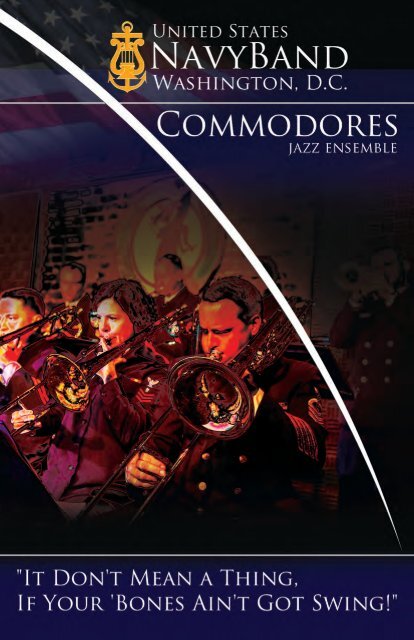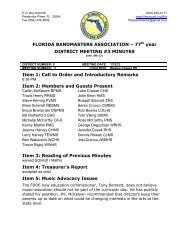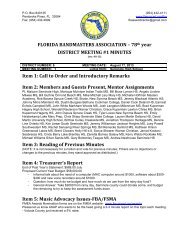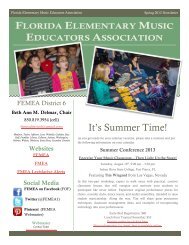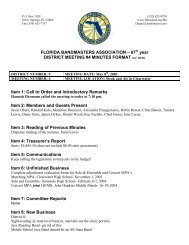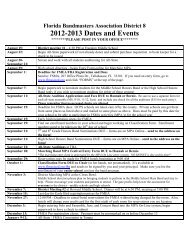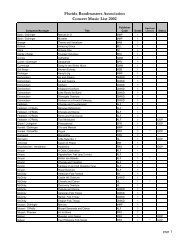U.S. Navy Band Commodores' trombone section clinic
U.S. Navy Band Commodores' trombone section clinic
U.S. Navy Band Commodores' trombone section clinic
You also want an ePaper? Increase the reach of your titles
YUMPU automatically turns print PDFs into web optimized ePapers that Google loves.
On behalf of the U.S. <strong>Navy</strong> <strong>Band</strong><br />
Washington, D.C., and our Commodores<br />
<strong>trombone</strong> <strong>section</strong> I would like to thank you<br />
for attending our <strong>clinic</strong>. The Commodores<br />
have been entertaining audiences for over<br />
40 years with their own special brand of<br />
world-class big band jazz. Their unit leader,<br />
Senior Chief Musician Phil Burlin and music<br />
director, Chief Musician Luis Hernandez,<br />
continue the long-standing tradition of<br />
programming arrangements and original<br />
compositions by current members. I am<br />
especially pleased to present this <strong>clinic</strong> to<br />
educators to assist in improving their big<br />
band <strong>trombone</strong> <strong>section</strong>.<br />
Based at the historic <strong>Navy</strong> Yard in<br />
Washington, D.C., the U.S. <strong>Navy</strong> <strong>Band</strong><br />
consists of five performing units in addition<br />
to the Commodores: the Concert/Ceremonial <strong>Band</strong>, the Sea Chanters<br />
chorus, Country Current, our country/bluegrass group and the Cruisers,<br />
a top-40 and R&B band. Our music ranges from military ceremonies, to<br />
wind ensemble repertoire and chamber music, choral works of all kinds,<br />
Broadway, Top 40, small group jazz and oldies, country, and bluegrass,<br />
entertaining audiences of all ages and musical preferences.<br />
I am delighted that we are providing an educational forum for high<br />
school and college band directors with the goal of encouraging young<br />
musicians to hone their craft. It is encouraging to see educators fostering<br />
the love of music for future generations. Thanks again for your attendance<br />
at our <strong>clinic</strong>.<br />
Brian O. Walden<br />
Captain, U.S. <strong>Navy</strong><br />
Commanding Officer/Leader
“It Don’t Mean a Thing,<br />
If Your ‘Bones Ain’t Got Swing!”<br />
Educators attending this <strong>clinic</strong> will walk away with many ideas for<br />
improving their high school or college big band <strong>trombone</strong> <strong>section</strong>. Some of<br />
the topics we will explore are <strong>section</strong> blend, balance, intonation, style and<br />
how the bone <strong>section</strong> fits in with the rest of the ensemble. You will be able<br />
to see firsthand how to address various issues in the <strong>trombone</strong> <strong>section</strong>, as<br />
the members of the Commodores <strong>trombone</strong> <strong>section</strong> illustrate key concepts,<br />
as well as work with a student <strong>section</strong>.<br />
A great <strong>trombone</strong> <strong>section</strong> benefits any ensemble, whether it’s<br />
orchestral, symphonic, or jazz. This <strong>clinic</strong> will address good fundamentals<br />
of <strong>trombone</strong> playing as part of a jazz <strong>trombone</strong> <strong>section</strong>, but the <strong>section</strong><br />
concepts apply for any genre. This handout will also provide educators a<br />
list of the Commodore’s favorite listening examples of great <strong>trombone</strong> solo<br />
and <strong>section</strong> playing. Also included is a list of educational resources that<br />
have been used by members of the <strong>section</strong>.<br />
Introduction<br />
The Four Fundamental<br />
Trombone Concepts<br />
I. Listen<br />
II. Sound<br />
III. Air<br />
IV. Technique<br />
Big <strong>Band</strong> Style, Influential<br />
Big <strong>Band</strong> Trombonists<br />
and Basic Improvisation Tips:<br />
MU1 David Perkel<br />
MU1 Jennifer Krupa<br />
I. Pyramid of listening<br />
in the big band setting<br />
II. Groove is the most important<br />
thing - applying concepts to all styles<br />
III. Extension of your voice.<br />
Sing what you hear, then play it.
The roles of the big MUC Matthew J. Neff<br />
band bass bone player:<br />
I. Play with <strong>section</strong> (balance & blend)<br />
II. Identify potential student<br />
a. Independent<br />
b. Rhythmically solid<br />
c. Good sound concept<br />
d. Solid pitch<br />
III. Four roles of a Bass Trombone:<br />
a. Soloist<br />
b. Baritone saxophone<br />
c. Solid time<br />
d. Listen<br />
Ways to learn jazz improvisation<br />
I. The importance of<br />
learning to play by ear<br />
II. Learning to improvise<br />
with various recordings<br />
MUC Jamie Way<br />
Section discusses the following: MUC Matthew J. Neff, MUC Jamie Way<br />
I. Daily practice duration MU1 Jennifer Krupa, MU1 David Perkel<br />
and method books<br />
II. Warm-up ideas<br />
III. Why each one of<br />
us got into music<br />
IV. Important musical<br />
influences<br />
program subject to change
The <strong>Navy</strong>’s premier jazz<br />
ensemble, the Commodores, presents<br />
the finest in America’s truly original<br />
music. A specialty unit of the United<br />
States <strong>Navy</strong> <strong>Band</strong> in Washington,<br />
D.C., the group features 18 of the<br />
<strong>Navy</strong>’s top jazz and “big band”<br />
musicians. Under the leadership of<br />
Senior Chief Musician Philip M. Burlin,<br />
the Commodores combine the best of<br />
jazz and popular music.<br />
Since their founding in 1969, the<br />
Commodores have become one of<br />
the most acclaimed jazz ensembles in<br />
the country. Many jazz legends have<br />
appeared with the group, including<br />
Jerry Bergonzi, Ray Charles, Louie<br />
Bellson, Terry Gibbs, Bob Mintzer,<br />
James Moody, Chris Potter, Clark<br />
Terry and Eugene “Snooky” Young.<br />
In addition, they have appeared on<br />
ABC’s “Good Morning, America.”<br />
They are highly sought after by the<br />
nation’s foremost jazz festivals and<br />
educational conferences such as The<br />
Midwest Clinic, the Detroit/Montreux<br />
Jazz Festival and the Elkhart<br />
(Ind.) Jazz Festival. They are also<br />
featured at the annual <strong>Navy</strong> <strong>Band</strong><br />
International Saxophone Symposium<br />
and have appeared at International<br />
Association of Jazz Educators (IAJE)<br />
Conventions.<br />
The Commodores trace their<br />
roots to before World War II, when<br />
<strong>Band</strong> members with jazz experience<br />
formed dance bands and rehearsed<br />
on an as-needed basis for specific<br />
occasions. Responding to public<br />
demand for unique types of music<br />
as well as the changing needs of<br />
<strong>Navy</strong> recruiting, then-Ensign Ned<br />
Muffley formed a dance band in<br />
1966 from members of the concert<br />
and ceremonial units, and in 1968,<br />
preparations began to make the<br />
ensemble a separate group. In<br />
January 1969, the Dance <strong>Band</strong><br />
officially became the Commodores<br />
jazz ensemble.<br />
Their performances are highenergy<br />
affairs that not only pay<br />
tribute to the legendary big bands of<br />
yesterday, but also feature original<br />
compositions by members of the<br />
group. In 2009, the Commodores<br />
released their latest compact disc,<br />
Directions, which featured many of<br />
these new compositions in addition<br />
to fresh arrangements of popular<br />
favorites. The Commodores continue<br />
to preserve the great heritage of jazz<br />
while also being an innovative force<br />
for the future.
From left to right Musicians 1st Class Jennifer Krupa and David Perkel<br />
and Chief Musicians Jamie Way and Matthew Neff.<br />
A native of<br />
Hollidaysburg,<br />
Penn., Matt<br />
Neff joined the<br />
Commodores as<br />
bass trombonist<br />
in October of<br />
2009. Prior to his<br />
appointment with<br />
the <strong>Navy</strong>’s premier<br />
jazz ensemble, he Neff served as<br />
bass trombonist with the Concert/<br />
Ceremonial <strong>Band</strong>, a position he<br />
held since joining the <strong>Navy</strong> <strong>Band</strong> in<br />
1992. He has performed as soloist<br />
on numerous occasions and served<br />
as bass trombonist with the <strong>Navy</strong><br />
<strong>Band</strong> Brass Quintet from 2003-<br />
2009. A multi-talented musician,<br />
Chief Neff has composed more than<br />
30 works for the <strong>Navy</strong> <strong>Band</strong> Brass<br />
Quintet, and has published several<br />
works for brass ensembles. He holds<br />
a Bachelor of Music from Penn State<br />
University and a Master of Music<br />
from The Catholic University of<br />
America.<br />
A strong advocate for music<br />
education, he has performed as<br />
guest artist/<strong>clinic</strong>ian at high schools<br />
and colleges throughout the country.<br />
He currently serves as adjunct<br />
professor of <strong>trombone</strong> at George<br />
Mason University.<br />
Jamie Way<br />
joined the<br />
<strong>Navy</strong> <strong>Band</strong> in<br />
1996. Prior to<br />
his appointment<br />
with the <strong>Navy</strong><br />
<strong>Band</strong>, Chief Way<br />
was a member<br />
of the United<br />
States Military<br />
Academy <strong>Band</strong> at West Point, New<br />
York, where he performed with<br />
the “Jazz Knights” jazz ensemble.<br />
He received a diploma from the<br />
Interlochen Arts Academy and a<br />
Bachelor of Music from the Eastman<br />
School of Music.<br />
Born in Rutland, Vt., his
family moved during his youth to<br />
Evanston, Wyo. where he was a<br />
student of Carson Sharp, formerly<br />
the principal trombonist of the Utah<br />
Symphony. In college, he studied<br />
jazz improvisation with pianist<br />
Bill Dobbins. His other <strong>trombone</strong><br />
teachers include John Marcellus and<br />
Raymond Premru. In his spare time<br />
he enjoys reading of all kinds and<br />
has a keen interest in <strong>trombone</strong><br />
instrument design.<br />
Jennifer<br />
Krupa, born in<br />
Connecticut and<br />
raised in Hemet,<br />
Calif., joined the<br />
<strong>Navy</strong> <strong>Band</strong> in<br />
2004. She earned<br />
a Bachelor of<br />
Music from the<br />
University of North Florida in 1994<br />
and an Artist Diploma from The<br />
Juilliard School in 2003, both in<br />
jazz studies performance. While at<br />
Juilliard, she studied <strong>trombone</strong> with<br />
Wycliffe Gordon and arranging with<br />
Ellington aficionado David Berger. In<br />
2003, she won positions in the IAJE<br />
Sisters jazz combo at the Henry<br />
Mancini Institute and performed<br />
throughout North America and<br />
Europe. In 2006, the 23rd Annual<br />
World Premiere Composition Series<br />
commissioned her to conduct and<br />
compose pieces for the University of<br />
Scranton Concert <strong>Band</strong> and Choir.<br />
Petty Officer Krupa has<br />
performed with Wynton Marsalis and<br />
The Lincoln Center Jazz Orchestra,<br />
the Wycliffe Gordon Quintet/Sextet,<br />
the Smithsonian Jazz Masterworks<br />
Orchestra, Sherrie Maricle & the<br />
DIVA Jazz Orchestra, and Christian<br />
McBride in addition to co-leading her<br />
own small group JLQ. She has also<br />
contributed arrangements to the<br />
last two Commodores recordings,<br />
in addition to serving as the<br />
Commodores Librarian. In her free<br />
time, she enjoys spending time with<br />
her family and training for athletic<br />
events.<br />
Dave Perkel,<br />
originally from St.<br />
Louis, Missouri,<br />
joined the <strong>Navy</strong><br />
<strong>Band</strong> in 2002 and<br />
as lead <strong>trombone</strong><br />
for the <strong>Navy</strong> <strong>Band</strong><br />
Commodores<br />
jazz ensemble.<br />
He earned a Bachelor of Music<br />
from the University of North Texas<br />
and a Master of Music from the<br />
Manhattan School of Music. A<br />
well-rounded orchestral and jazz<br />
artist, he has performed with the<br />
National Symphony Orchestra,<br />
the Kennedy Center Opera House<br />
Orchestra, the Richmond Symphony,<br />
Virginia Symphony, Harrisburg<br />
Symphony and the San Antonio<br />
Symphony Orchestra. In 1999, he<br />
was appointed principal trombonist<br />
in the Annapolis Symphony and<br />
later performed the Overture for<br />
Trombone and Strings by Alan<br />
Hovhaness for a subscription series.<br />
As a jazz musician, Petty Officer<br />
Perkel was a member and featured<br />
soloist of the famed University of<br />
North Texas One O’clock Lab <strong>Band</strong><br />
and the Dallas Jazz Orchestra.<br />
Petty Officer Perkel is an active<br />
educator, having spent five years<br />
as an Artist in Residence at the<br />
Sewanee Summer Music Festival<br />
in Tennessee. He has taught at<br />
many schools in the Washington<br />
D.C. metropolitan area and had a<br />
one-year teaching appointment at<br />
Towson University. In his free time,<br />
he enjoys spending time with family.
The following is for information purposes ONLY. The <strong>Navy</strong> <strong>Band</strong> does<br />
NOT endorse or promote the following products and materials. Inclusion<br />
in this program is not to be construed as an endorsement, promotion or<br />
recommendation of any kind by the <strong>Navy</strong> <strong>Band</strong> or the United States <strong>Navy</strong>.<br />
Recommended Jazz<br />
Trombone Albums<br />
J.J. Johnson<br />
First Place<br />
The Trombone Master<br />
-Misterioso<br />
-Laura (BALLAD)<br />
-What Is This Thing Called Love<br />
-Blue Trombone<br />
The Eminent J.J. Johnson -<br />
volume 2 (& vol. 1)<br />
-All of the selections are great.<br />
-“Jay” and “Coffee Pot” are smoking!<br />
Stan Getz and J.J. Johnson<br />
At the Opera House<br />
(CLASSIC BEBOP TROMBONE)<br />
J.J. Johnson and Al Grey<br />
“Things Are Getting Better All the Time”<br />
Wycliffe Gordon<br />
The Search<br />
Slidin’ Home<br />
-Mood Indigo<br />
-“It Don’t Mean a Thing” & “Blooz”<br />
(PLUNGER)<br />
United Soul Experience<br />
-Karen’s Contemplation<br />
(BALLAD)<br />
-Low Key Lightly<br />
(MUTED PLUNGER BALLAD)<br />
John Allred & Wycliffe Gordon<br />
Head To Head<br />
- Louis Armstrong’s “West End Blues”<br />
- Horace Silvers’ “The Preacher”<br />
- “Sophisticated Lady”<br />
- “I Got It Bad”<br />
Frank Rosolino<br />
Frank Rosolino Quintet<br />
- Cherry<br />
- Let’s Make It<br />
- How Long Has This Been Going On<br />
(BALLAD)<br />
Turn Me Loose (Rosolino also sings on<br />
album)<br />
- Too Marvelous For Words<br />
- Please Don’t Bug Me<br />
- Pennies From Heaven<br />
Jack Teagarden<br />
“Mis’ry and the Blues”<br />
“Bobby Hackett & Jack Teagarden”<br />
(DIXIELAND & the SWING ERA)<br />
Curtis Fuller<br />
Blues-ette<br />
The Curtis Fuller Jazztet with Benny<br />
Golson<br />
- I’ll Walk Alone<br />
(BALLAD)<br />
- It’s All Right With Me<br />
- Judy’s Dilemma<br />
(BEBOP)<br />
Ray Anderson<br />
On John Scofield’s “Electric Outlet”<br />
(Ray solos on two songs)<br />
-Pick Hits (at 4:53)<br />
-Just My Luck (at 3:04)<br />
(FUNK / ROCK STYLES)<br />
J P Torres<br />
“Trombone Man” and “Cuba Swings”<br />
(LATIN AMERICAN / CUBAN STYLES)<br />
Fred Wesley<br />
On Maceo Parker’s<br />
“Live on Planet Groove”<br />
Wesley solos on “Pass the Peas”<br />
(FUNK)<br />
Alan Kaplan<br />
“Lonely Town”<br />
(LYRICAL BALLAD STYLE)<br />
Bill Watrous<br />
“Bone-ified”<br />
“Manhattan Wildlife Refuge”<br />
Carl Fontana<br />
“The Great Fontana”<br />
Bobby Shew’s “Heavyweights”
Michael Davis<br />
(www.hip-bonemusic.com)<br />
Bobby Knight’s Great American<br />
Trombone Co.<br />
(www.davisandjones.com/jazzmark<br />
jmorder.pdf)<br />
Matt Finders<br />
(www.mattfinders.com)<br />
Commercially<br />
successful <strong>trombone</strong>s<br />
Urbie Green, Dick Nash<br />
Current modern trombonists<br />
Steve Turre, Conrad Herwig, Wycliffe<br />
Gordon, John Allred, Robin Eubanks,<br />
Steve Davis, Vincent Gardner, Luis<br />
Bonilla, Ray Anderson, Michael Davis,<br />
Ryan Keberle, Marshall Gilkes<br />
Other recommended albums and<br />
educational resources<br />
Jazz Albums<br />
1. Miles Davis - Kind of Blue<br />
2. John Coltrane - Blue Train<br />
3. Sonny Rollins - Saxophone Colossus<br />
4. Dizzy Gillespie, Sonny Rollins &<br />
Sonny Stitt - Sonny Side Up<br />
5. Charlie Parker - The Legendary<br />
Dial Masters, Vol. 1<br />
6. Art Blakey and the Jazz<br />
Messengers - 1958 Paris Olympia<br />
7. Ahmad Jamal - Live at the Pershing<br />
8. Louis Armstrong & Oscar Peterson<br />
- Louis Armstrong<br />
Meets Oscar Peterson<br />
9. Hank Mobley - Soul Station<br />
10. Bill Evans - Portrait in Jazz<br />
or Waltz For Debby<br />
11. Wynton Marsalis -<br />
Standard Time vol. 1 or 2<br />
12. Chet Baker -<br />
It Could Happen To You<br />
or Someday My Prince Will Come<br />
13. Lee Morgan – Sidewinder<br />
Big <strong>Band</strong> Albums<br />
Count Basie and The Orchestra - Sinatra<br />
at the Sands in concert<br />
Sarah Vaughan and the Count Basie<br />
Orchestra - Send in the Clowns<br />
Count Basie and His Orchestra - This<br />
Time by Basie (Hits of the 50’s and 60’s)<br />
Duke Ellington - The Great Paris Concert<br />
Woody Hermann<br />
Stan Kenton<br />
Maria Schneider<br />
Rob McConnell<br />
Bob Florence<br />
Jazz Trombone Group CD’s<br />
Slide Hampton - World of Trombones<br />
Capitol Bones - My Favorite Things;<br />
Stan Kenton Christmas<br />
New York Trombone Conspiracy - A<br />
Matter of Time<br />
Classical Trombone Group CD’s<br />
London Trombone Artists - London<br />
Trombone Sound<br />
Trombones de Costa Rica - Imagenes;<br />
Contrastes<br />
Classical Trombone CD’s<br />
Slide Area by Joseph Alessi<br />
Towards the Light by Nitzan Haroz<br />
Audition Window - Timeless Trombone<br />
Tales by Carl Lenthe<br />
10 year Jubilee by Christian Lindberg<br />
The Burlesque Trombone by Christian<br />
Lindberg<br />
Offroad by James Markey<br />
Proof by Ko-ichiro Yamamoto<br />
X Over <strong>trombone</strong> by Jim Pugh and the<br />
Colorado Symphony
Classical Bass Trombone CD’s<br />
Fancy Free by Blair Bollinger<br />
Melodrama - Romantic Music from<br />
Russia by Randall Hawes<br />
First Song; Nana by Ben Van Dijk<br />
Bass Trombone by Charles Vernon<br />
Proclamation; Two of a Mind (with Nick<br />
Hudson) by Douglas Yeo<br />
EDUCATIONAL RESOURCES<br />
Play along CD’s<br />
(Aebersold’s and others)<br />
JAZZ METHOD BOOKS<br />
Exercises & Etudes by J. J. Johnson<br />
Bop Duets by Bugs Bower<br />
Patterns for Jazz by Jerry Coker<br />
Jazz Conception by Jim Snidero (for<br />
tenor or bass)<br />
12 Jazz Duets; 24 Jazz Etudes by Jack<br />
Gale<br />
CLASSICAL METHOD BOOKS<br />
(Most of these books are at<br />
www.hickeys.com)<br />
The F Attachment and Bass Trombone<br />
by Allen Ostrander<br />
Complete Method for Trombone and<br />
Euphonium by Arban - revised by Joseph<br />
Alessi and Dr. Brian Bowman<br />
Daily Drills and Technical Studies for<br />
Trombone by Max Schlossberg<br />
The Remington Warm-Up edited by<br />
Donald Hunsberger<br />
Melodious Etudes for Trombone by<br />
Bordogni (Rochut) - Volumes 1, 2 and 3<br />
Lyrical Etudes for Trombone by Phil<br />
Snedecor<br />
Introductory Studies in Tenor and Alto<br />
Clef by Brad Edwards<br />
Rhythmical Studies by Marcel Bitsch<br />
Sixty Selected Studies for Trombone by<br />
George Kopprasch<br />
METHOD BOOKS FOR BASS<br />
TROMBONE<br />
(good transition books<br />
for tenor players)<br />
Gillis - 70 Progressive studies; 20 etudes<br />
Pederson - elementary, intermediate,<br />
advanced etudes<br />
Notes:
Notes:
Receive fanfare in your mailbox!!<br />
fanfare is the <strong>Navy</strong> <strong>Band</strong>’s bimonthly newsletter<br />
featuring a performance schedule, articles on past and upcoming events and<br />
<strong>Navy</strong> <strong>Band</strong> history, <strong>Navy</strong> <strong>Band</strong> vacancies, a message from the commanding officer,<br />
notable quotes and Spotlight.<br />
To receive fanfare, email us at<br />
<strong>Navy</strong><strong>Band</strong>.Public.Affairs@navy.mil<br />
with your request. Please include:<br />
name (first, last and title)<br />
Street address<br />
city, state, and zip code<br />
For information about the <strong>Navy</strong> Music program call 1-800-962-1425.<br />
For more information about <strong>Navy</strong> opportunities<br />
call 1-800-USA-NAVY or visit www.navyjobs.com<br />
Audio/video recording of this performance must have prior written approval<br />
from the <strong>Navy</strong> <strong>Band</strong>’s Public Affairs Office.<br />
To comment on this program,<br />
address correspondence to:<br />
Office of the Chief of Information<br />
1200 <strong>Navy</strong> Pentagon<br />
Washington, D.C. 20350-1200<br />
or<br />
Public Affairs Office<br />
United States <strong>Navy</strong> <strong>Band</strong><br />
617 Warrington Ave. SE<br />
Washington <strong>Navy</strong> Yard, DC 20374-5054<br />
or<br />
navyband.comments@navy.mil<br />
Visit us on the web:<br />
www.navyband.navy.mil<br />
www.facebook.com/usnavyband<br />
www.twitter.com/theusnavyband<br />
www.youtube.com/usnavyband


